Tuesday, November 19, 2024, The Postgraduate Arabic Language Education Doctoral Study Program of UIN Maulana Malik Ibrahim Malang held a National Webinar with the theme “Arabic Language Learning Technology”. The webinar, which was initiated by the Arabic Language Education Study program, was conducted online through the Zoom Meeting channel which was attended by more than 100 participants, including teachers, students, lecturers, and Arabic language learning practitioners. This webinar can also be watched live on the YouTube channel of the Postgraduate Program of UIN Maulana Malik Ibrahim Malang. https://www.youtube.com/live/Mplyvv4L_WQ
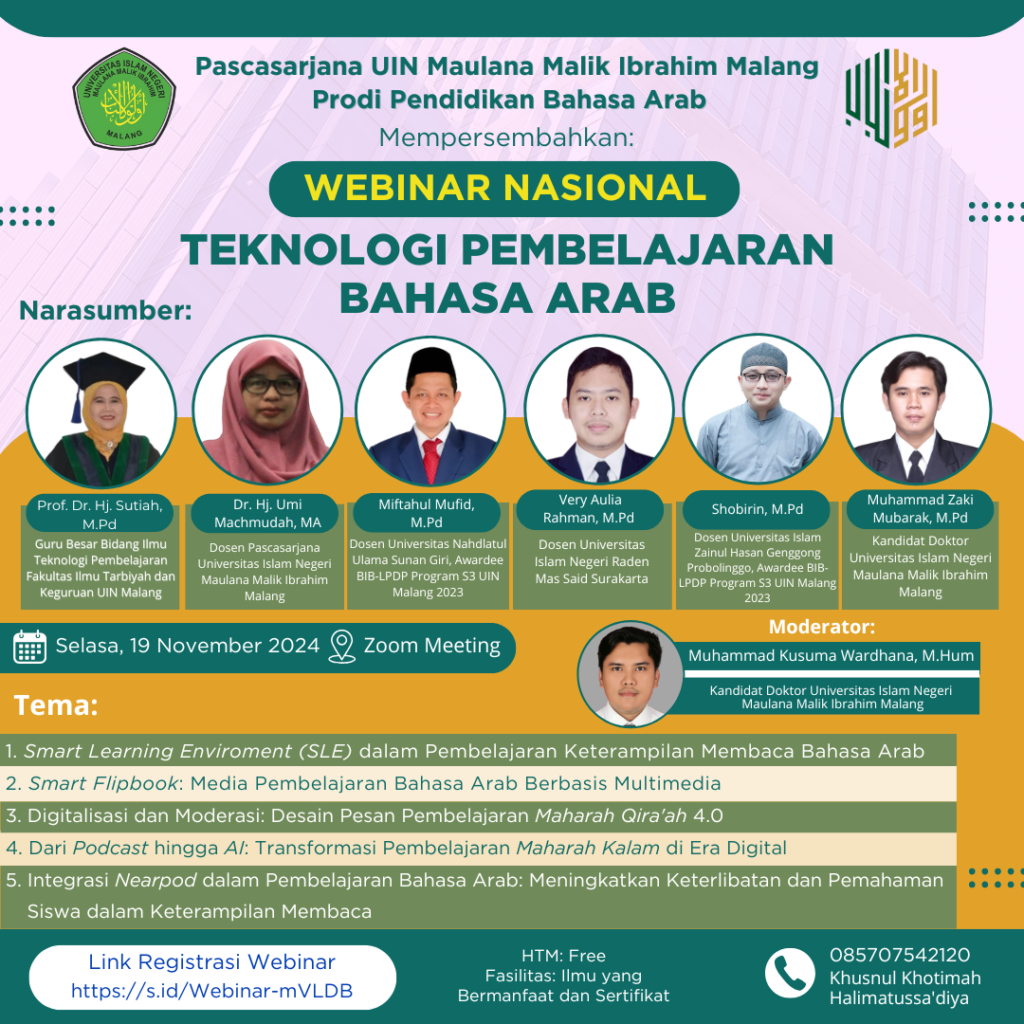
The webinar activity was officially opened by the Postgraduate director of UIN Maulana Malik Ibrahim Malang, Prof. Dr. Wahidmurni, M.Pd. In his remarks, he said that the use of technology is needed to increase the effectiveness and efficiency of learning. Although the presence of technology has positive and negative impacts, educators are expected to sort out the use of technology that can support learning. He also expressed his appreciation for the implementation of this national webinar. It is hoped that the implementation of this webinar can increase in quantity so that it can contribute more to improving learning.
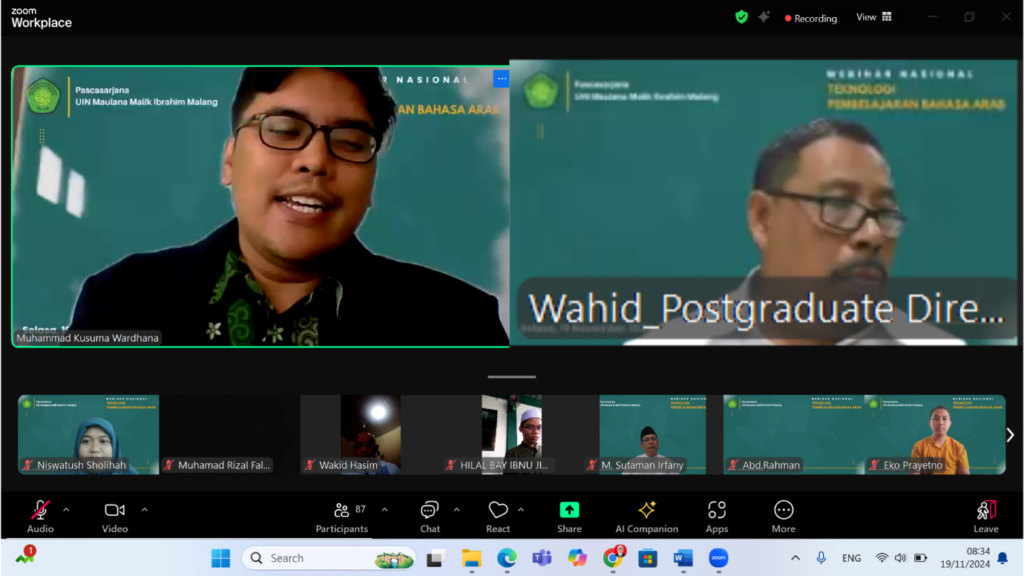
This Werbinar activity presents experts and practitioners of Arabic Language Education as speakers. The first speaker was Prof. Dr. Hj Sutiah, M.Pd. who carried the theme “Arabic Learning Technology”. She conveyed the concept and urgency of digital transformation of Arabic Language Learning innovation, as well as the need for theories and models in integrating technology in Arabic Language Learning.

Muhammad Shobirin, M.Pd. with the theme “From Podcast to AI: Transformation of Maharah Kalam Learning in the Digital Era”. He explained that Maharah Kalam learning in Arabic underwent a major transformation with the presence of digital technology, especially AI. This technology allows students to practice speaking in a more personalized, flexible, and adaptive environment. He recommended improving training for educators, developing more inclusive and user-friendly applications, and emphasizing the importance of cultural awareness in the use of technology in Arabic language learning.
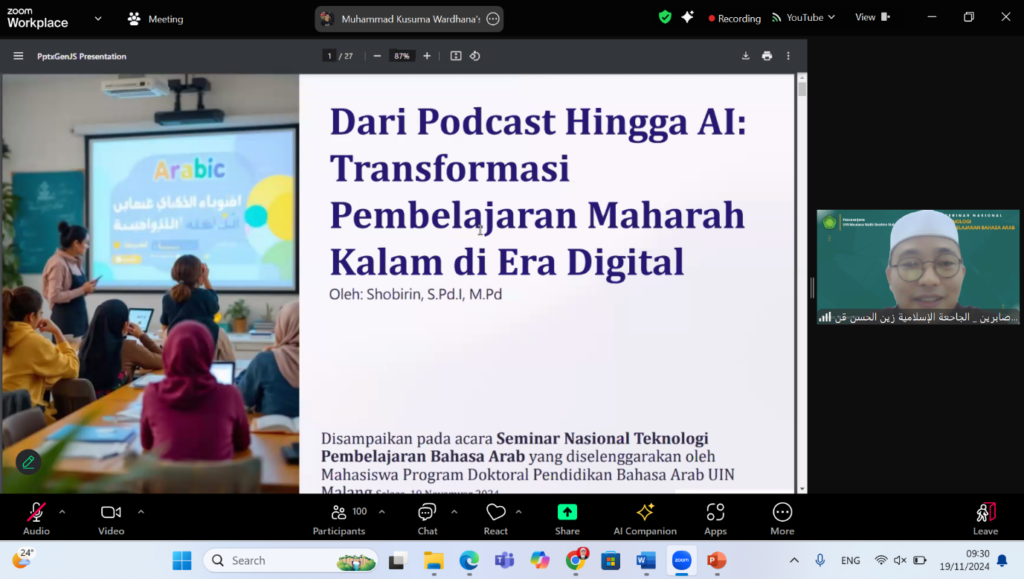
Very Aulia Rahman, M.Pd. with the theme “Smart FlipBook: Multimedia-based Arabic Learning Media”. He began with a reflection on whether learning so far can make students learn, both in the classroom and outside the classroom. To support this, he offered solutions to innovate media, methods or learning resources. One of the media innovations that he exemplifies is the use of smart flipbooks. Smart Flipbook is a digital form of a book that can be flipped like a physical book, usually with animation effects to simulate flipping pages. Serves to convey information in a more interactive format than static text. The use of this smart flipbook is expected to present the material to be more interesting and increase interest in learning. In addition, this application is also environmentally friendly and easily accessible anywhere and anytime so that students can learn independently outside of school hours.
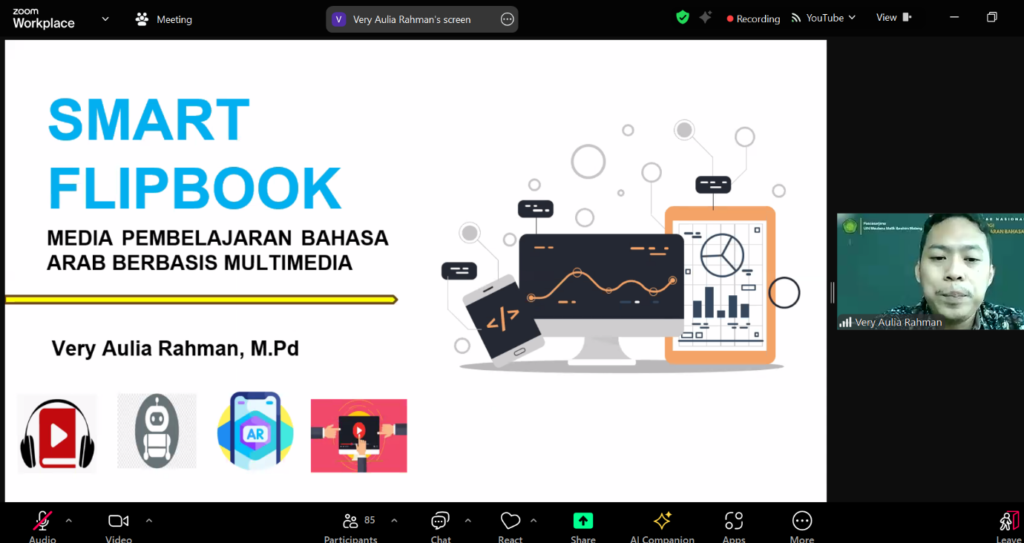
In the question and answer session, Novi Lusiana from Bojonegoro asked how to foster a love of Arabic in students? how to strive for inclusive learning for students. Which was answered by Shobirin.
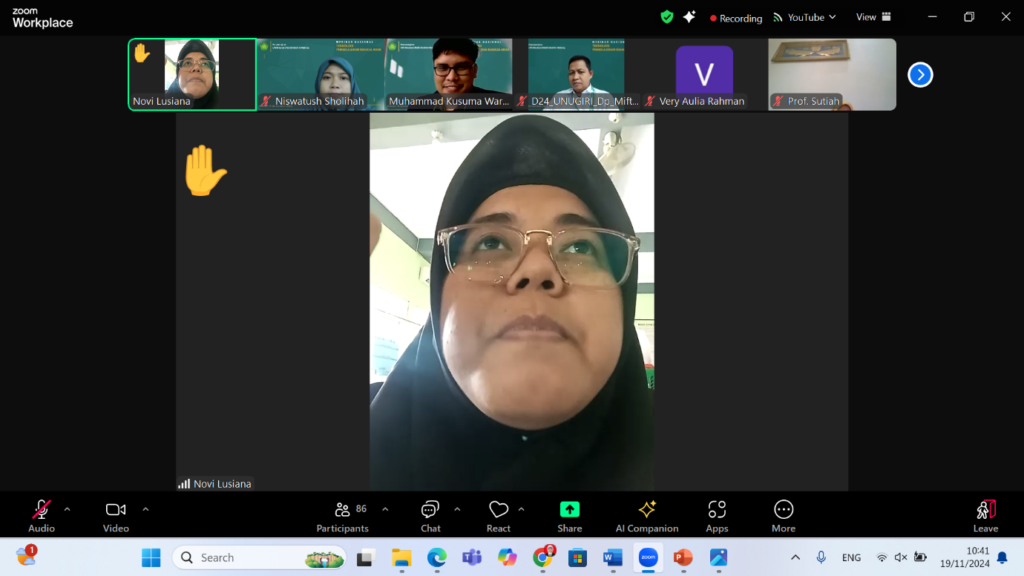
Dr. Hj Umi Machmudah, M.A. with the theme “SMART Learning Enviroment (SLE) in Learning Arabic Reading Skills (Maharah Qiro'ah)”. He said that technology in the context of educational technology aims to overcome various learning problems and improve performance and learning outcomes. Learning environment is a place where people can gather, learn, and grow. Learning environments are designed to provide opportunities for students to learn in a variety of ways. SMART includes Showing, Manageable, Accessible, Real-time interaction, and Testing.
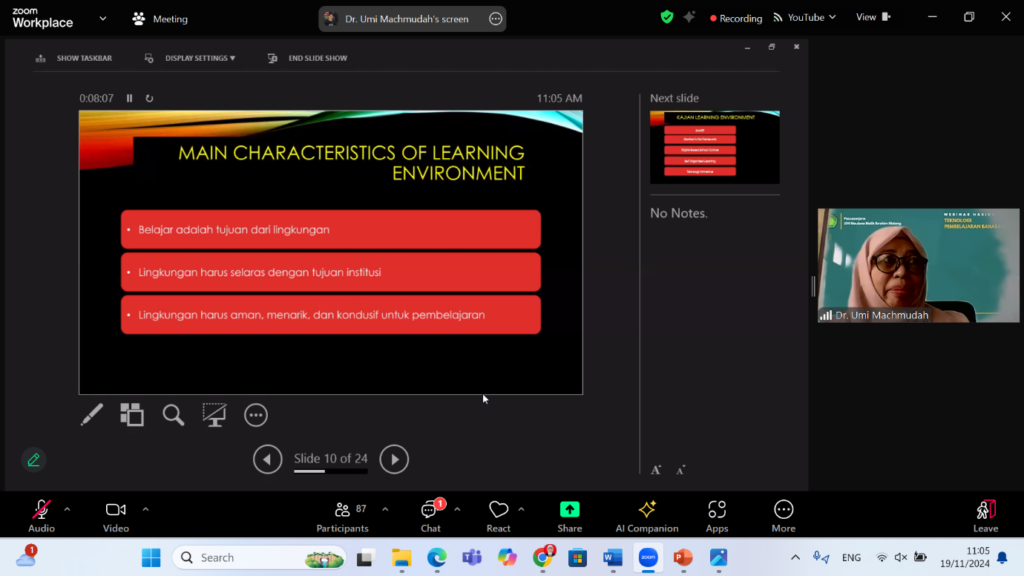
Showing is a way of presenting material tailored to the cognitive characteristics of students. This implies that in this way, the content presented will be more “clear”. The “material” taught is in accordance with student development. With these characteristics, students are easily attracted so that learning is not boring. This will help improve understanding and processing of material acquisition. Manageable: Flexible layout supports teaching activities. Environmental management mainly characterizes the diversity of layout and convenience of SMART learning environment management. All classroom equipment, systems and resources should have strong management, including classroom layout management, equipment, physical environment management, electrical safety management, and network management. This includes the layout of the visuals or slides being shown, which is also very supportive. AccessibleThe abundance of resources is very helpful in applying various methods. Resource acquisition, especially with the ability to acquire resources and easy access to equipment in the classroom, will support successful learning. Ease of access to resources usually involves 3 aspects namely: resource selection (in this case ICP students majoring in Arabic), content distribution (in this case PPT links, videos, material scripts), and access speed (in this case the availability of wifi support). Real-time InteractionThe resources available are helpful in finding problems and providing feedback in a “just in time” manner. Timely interactions are characterized by the ability of the SMART learning environment to support teaching interactions (teacher with students, students with materials) and student interactions. This kind of learning involves 3 aspects, viz: facilitation, interaction fluency and interactive tracking. Test (Testing), The ability to understand the physical environment and learning behavior is the basis of the SMART learning environment. Situational perception mainly characterizes the ability to the physical environment and learning behavior in the SMART learning environment. Testing or proving here means that when the classroom environment is equipped with technological equipment and carrying capacity, teachers can implement technology-based learning strategies or e-learning. This is evidenced by the impact of good learning outcomes through tests.
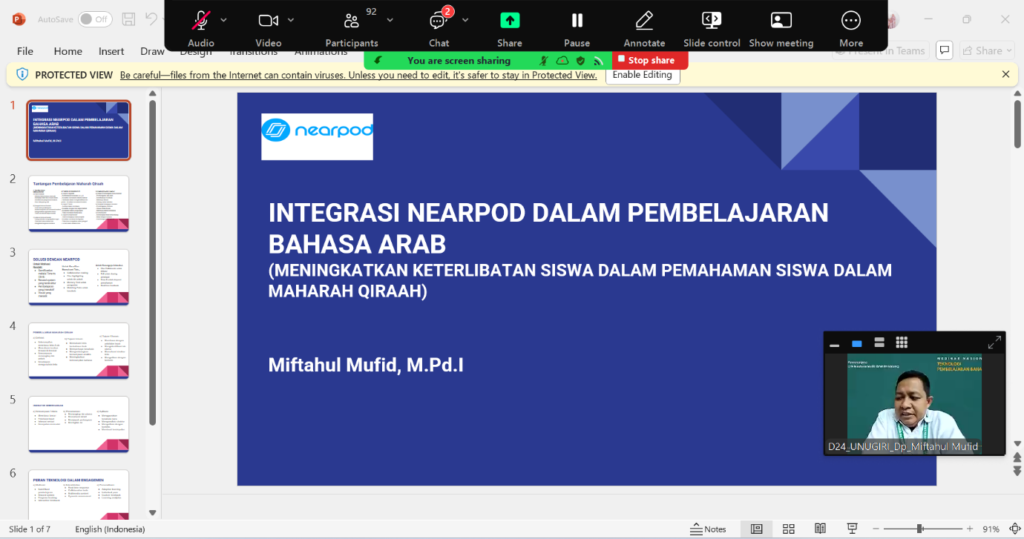
Miftahul Mufid, M.Pd. with the theme “Nearpod Integration in Arabic Language Learning: Increasing Student Engagement and Understanding in Reading Skills”. He conveyed the challenges of learning Maharah Qira'ah, namely students' difficulties in understanding the text, low student motivation, and lack of interaction in conventional learning. For this reason, he provided a solution to integrate Nerapos in learning. Among the forms of integration are Gamification through time to climb, structured reward system, interactive learning, use of collaborative reading features, highlighting features for main ideas, memory test for reinforcement, matching pairs for vocabulary, and many more features.
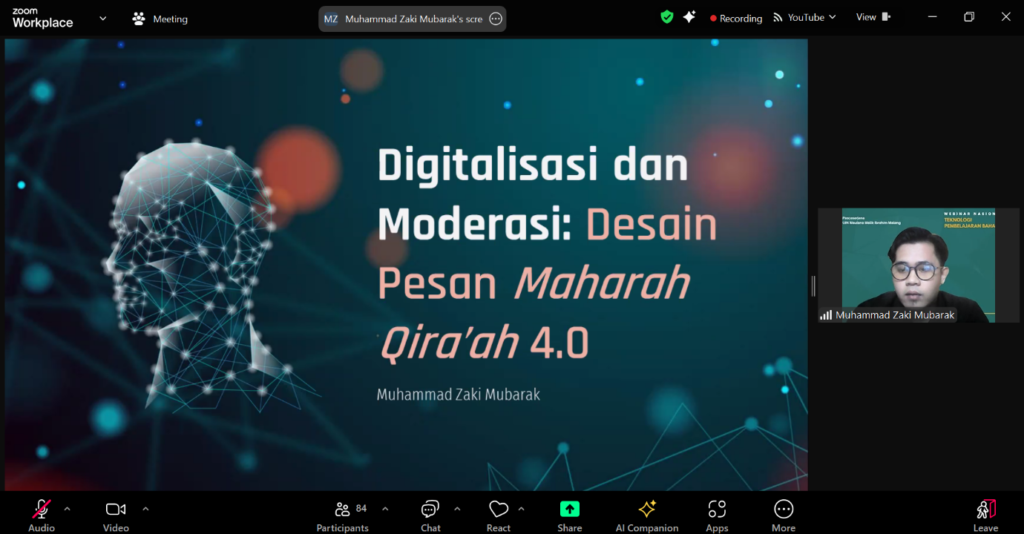
Muhammad Zaki Mubarak, M.Pd. with the theme “Digitalization and Moderation: Learning Message Design for Maharah Qira'ah 4.0”. Digitalization in education is the process of integrating digital technology into various aspects of learning, such as media, methods, and curriculum, to improve accessibility, efficiency, and quality of education. UNESCO and UNICEF appointed Indonesia to organize the Gateways study visit. Gateways is a global initiative run by UNESCO and UNICEF for countries to build and improve digital learning platforms for the public. This cross-border cooperation aims to ensure that all students, education actors and families have access to quality digital education platforms and content. Moderation is applied to fortify students' understanding of various distorted digital media information, as well as to shape the personalities of students who are Rahmatan lil 'Alamin.
This webinar is a development of the Information Technology lecture in Arabic language learning. by holding this webinar, it is hoped that practitioners and observers of Arabic language education in particular can benefit from the application of technology in Arabic language learning.
